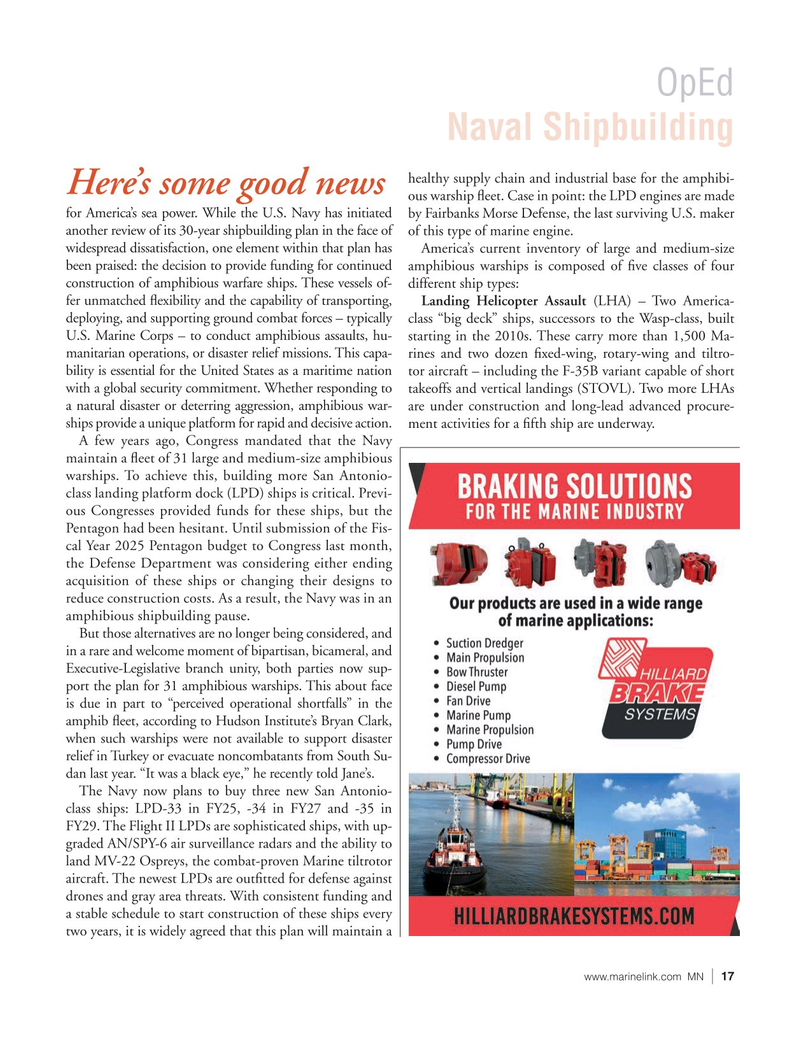
Page 17: of Marine News Magazine (June 2024)
Read this page in Pdf, Flash or Html5 edition of June 2024 Marine News Magazine
OpEd
Naval Shipbuilding healthy supply chain and industrial base for the amphibi-
Here’s some good news ous warship ? eet. Case in point: the LPD engines are made for America’s sea power. While the U.S. Navy has initiated by Fairbanks Morse Defense, the last surviving U.S. maker another review of its 30-year shipbuilding plan in the face of of this type of marine engine. widespread dissatisfaction, one element within that plan has America’s current inventory of large and medium-size been praised: the decision to provide funding for continued amphibious warships is composed of ? ve classes of four construction of amphibious warfare ships. These vessels of- different ship types: fer unmatched ? exibility and the capability of transporting, Landing Helicopter Assault (LHA) – Two America- deploying, and supporting ground combat forces – typically class “big deck” ships, successors to the Wasp-class, built
U.S. Marine Corps – to conduct amphibious assaults, hu- starting in the 2010s. These carry more than 1,500 Ma- manitarian operations, or disaster relief missions. This capa- rines and two dozen ? xed-wing, rotary-wing and tiltro- bility is essential for the United States as a maritime nation tor aircraft – including the F-35B variant capable of short with a global security commitment. Whether responding to takeoffs and vertical landings (STOVL). Two more LHAs a natural disaster or deterring aggression, amphibious war- are under construction and long-lead advanced procure- ships provide a unique platform for rapid and decisive action. ment activities for a ? fth ship are underway.
A few years ago, Congress mandated that the Navy maintain a ? eet of 31 large and medium-size amphibious warships. To achieve this, building more San Antonio- class landing platform dock (LPD) ships is critical. Previ- ous Congresses provided funds for these ships, but the
Pentagon had been hesitant. Until submission of the Fis- cal Year 2025 Pentagon budget to Congress last month, the Defense Department was considering either ending acquisition of these ships or changing their designs to reduce construction costs. As a result, the Navy was in an amphibious shipbuilding pause.
But those alternatives are no longer being considered, and in a rare and welcome moment of bipartisan, bicameral, and
Executive-Legislative branch unity, both parties now sup- port the plan for 31 amphibious warships. This about face is due in part to “perceived operational shortfalls” in the amphib ? eet, according to Hudson Institute’s Bryan Clark, when such warships were not available to support disaster relief in Turkey or evacuate noncombatants from South Su- dan last year. “It was a black eye,” he recently told Jane’s.
The Navy now plans to buy three new San Antonio- class ships: LPD-33 in FY25, -34 in FY27 and -35 in
FY29. The Flight II LPDs are sophisticated ships, with up- graded AN/SPY-6 air surveillance radars and the ability to land MV-22 Ospreys, the combat-proven Marine tiltrotor aircraft. The newest LPDs are out? tted for defense against drones and gray area threats. With consistent funding and a stable schedule to start construction of these ships every two years, it is widely agreed that this plan will maintain a www.marinelink.com MN 17|

 16
16

 18
18
